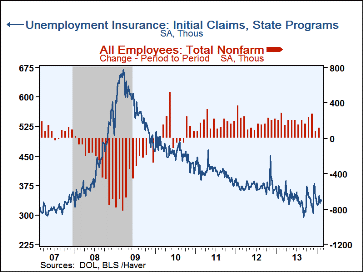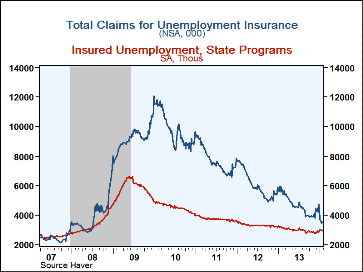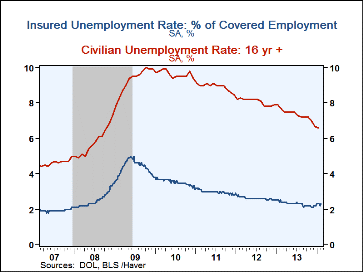 Global| Feb 20 2014
Global| Feb 20 2014U.S. Initial Claims for Unemployment Insurance Slip
by:Tom Moeller
|in:Economy in Brief
Summary
Initial claims for unemployment insurance edged down to 336,000 (-8.2% y/y) during the week ended February 15 versus an unrevised 339,000 during the week prior. Expectations had been for 335,000 claims in the Action Economic forecast [...]
 Initial claims for unemployment insurance edged down to 336,000 (-8.2%
y/y) during the week ended February 15 versus an unrevised 339,000 during
the week prior. Expectations had been for 335,000 claims in the Action
Economic forecast survey. The four-week moving average of initial claims
ticked up to 338,500.
Initial claims for unemployment insurance edged down to 336,000 (-8.2%
y/y) during the week ended February 15 versus an unrevised 339,000 during
the week prior. Expectations had been for 335,000 claims in the Action
Economic forecast survey. The four-week moving average of initial claims
ticked up to 338,500.
This week's initial claims figure covers the survey week for February nonfarm payrolls and claims were up 7,000 (2.1%) from January. During the last ten years there has been a 75% correlation between the level of initial claims and the m/m change in payroll employment.
Continuing claims for unemployment insurance in the week ended February 8 increased to 2.981 million (-5.8% y/y). The four-week moving average slipped to 2.960 million and still was near its highest level since early August. The insured rate of unemployment nudged up to 2.3% from a downwardly revised 2.2%. This particular count covers only "regular" programs and does not include all extended benefit and other specialized jobless insurance programs. In the week of February 1, the latest available, the total of all benefit recipients was little-changed at 3.525 million (-36.8% y/y). This broader measure is not seasonally adjusted. It compares to a cycle peak of 12.060 million in January 2010 and pre-recession figures that averaged 2.596 million in 2007.
Data on weekly unemployment insurance are contained in Haver's WEEKLY database and they are summarized monthly in USECON. Data for individual states are in REGIONW. The expectations figure is from the Action Economics survey, carried in the AS1REPNA database.
| Unemployment Insurance (000s) | 02/15/14 | 02/08/14 | 02/01/14 | Y/Y % | 2013 | 2012 | 2011 |
|---|---|---|---|---|---|---|---|
| Initial Claims | 336 | 339 | 331 | -8.2 | 343 | 374 | 409 |
| Continuing Claims | -- | 2,981 | 2,944 | -5.9 | 2.980 | 3,319 | 3,742 |
| Insured Unemployment Rate (%) | -- | 2.3 | 2.2 | 2.4 (2/13) |
2.3 | 2.6 | 3.0 |
| Total "All Programs" (NSA) | -- | -- | 3.525 mil. | -36.8 | 4.659 mil. | 6.047 mil. | 7.750 mil. |
Tom Moeller
AuthorMore in Author Profile »Prior to joining Haver Analytics in 2000, Mr. Moeller worked as the Economist at Chancellor Capital Management from 1985 to 1999. There, he developed comprehensive economic forecasts and interpreted economic data for equity and fixed income portfolio managers. Also at Chancellor, Mr. Moeller worked as an equity analyst and was responsible for researching and rating companies in the economically sensitive automobile and housing industries for investment in Chancellor’s equity portfolio. Prior to joining Chancellor, Mr. Moeller was an Economist at Citibank from 1979 to 1984. He also analyzed pricing behavior in the metals industry for the Council on Wage and Price Stability in Washington, D.C. In 1999, Mr. Moeller received the award for most accurate forecast from the Forecasters' Club of New York. From 1990 to 1992 he was President of the New York Association for Business Economists. Mr. Moeller earned an M.B.A. in Finance from Fordham University, where he graduated in 1987. He holds a Bachelor of Arts in Economics from George Washington University.








